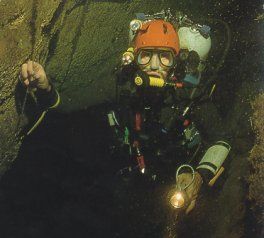
GAS MANAGEMENT
The cylinders
need to be kept balanced for emergency use. Normal practice is to switch
each time a third has been used, i.e. use a third of the left tank, switch,
use a third of the right, switch, third of left, switch, finally third
of the right. To minimise switches, sidemount cave divers will normally
use a third off one tank, switch, use two thirds off the other, switch,
use another third from the original. This works out the same, but requires
one less regulator switch.
This all requires careful monitoring and attention. Getting it wrong severely endangers the diver's safety. Try tracking the switches under stress. There have even been cases of divers using one tank until empty before making the first switch, the regulator freeflows and they have no back-up.
SHARING GAS
Two divers
with independant tanks should never need to share gas. But what if they
do? A long hose is necessary for stress free sharing, but which regulator
do you put it on? Remember, you need to switch regulators throughout the
dive. When you need to share gas then the long hose may be what you are
breathing, or maybe it is not depending on at what point the emergency
occurs.
Do you put it on the right as normal?
Or on the left?
Do you have two?
Maybe you don't take one at all?
Does the out of air diver take the regulator from your mouth? Or from a strap?
There is no
answer. Logistically, it is a horrendous situation to be in.
Independants mean that the diver does not have to worry about gas loss. Even if one cylinder empties completely then the other will have an intact gas supply. An isolation manifold could have given better management of the emergency in the first place but this assumes the diver can reach the manifold every single time.
In theory, two divers with independant cylinders will never need to share air because they will always have two redundant air sources. A long hose regulator is never needed.
Each cylinder must have one second stage, one HP gauge and an inflator hose (assuming a drysuit is used). They are banded together and attached to a backplate as before. The right cylinder feeds the wing and the left feeds the drysuit. The left gauge is clipped to the left d-ring, the right gauge runs under-arm and is clipped off on the right shoulder d-ring.
The biggest problems are where to put the 2nd stages and how to identify each one. If both regulators come over the right shoulder then there is no easy way to tell which one you are breathing. One option is to use different coloured face plates, or different 2nd stage designs. Another is to feed the left reg over the left shoulder and have the right reg coming over the right shoulder. However a standard 2nd stage will be upside down on the left! Some regulators, like Scubapros, can have the hose reversed to make it left handed. Others, like Poseidon and Oceanic Omegas, can be used either way up. The trouble with this is that they are particularly good regulators. Whichever method you use, the potential for confusion, especially under stress, is huge.
This is a typical rig for backmounts:
Wing, backplate & harness as standard. Right reg comes over right shoulder, gauge clipped on right side, 2nd stage on long hose, wrapped as normal. LP feed to wing. Left reg is a left-hand Scubapro on a shortened hose, left gauge clipped to left side, drysuit feed under left arm.
Sidemount diving is the only really
workable way of using independants. Backmounts are totally impossible,
use a manifold. The exception is possibly solo diving, but the use of independants
is more a reassurance, a "comfort blanket" like pony bottles, than of any
actual benefit. The causes of accidents are rarely directly related to
major equipment failures.